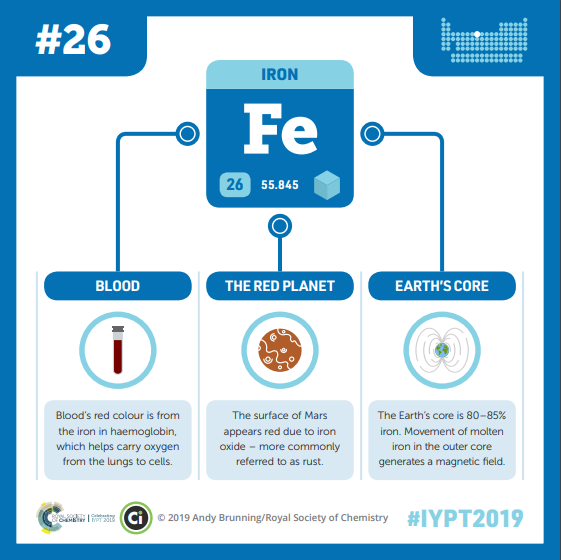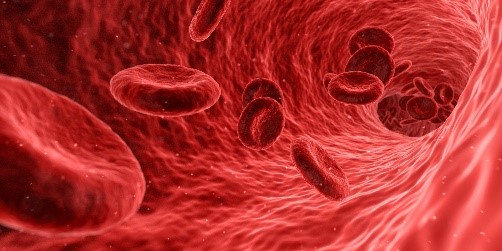Our blood appears red for the same reason the planet Mars does: iron. The element may bring to mind cast-iron pans, wrought-iron fences, or ancient iron tools, but it’s also essential to life on Earth. All living organisms, from humans to bacteria, need iron. It’s crucial for many processes in the human body, including oxygen transport, muscle function, proper growth, cell health, and the production of several hormones.
 Iron is the reason both our blood and the planet Mars appear red. The element also makes up the majority of Earth’s core and generates the planet’s magnetic field. Credit: Compound Interest. CC BY-NC-ND 4.0. Click to enlarge
Iron is the reason both our blood and the planet Mars appear red. The element also makes up the majority of Earth’s core and generates the planet’s magnetic field. Credit: Compound Interest. CC BY-NC-ND 4.0. Click to enlarge
Special Delivery: Oxygen

About two-thirds of the iron in our bodies is found in a protein called hemoglobin, which is part of red blood cells. Each hemoglobin molecule contains four iron atoms. Oxygen molecules grab on to these atoms when red blood cells pass through the lungs and are later released as the cells move around the body. Other cells use oxygen molecules from red blood cells to produce adenosine triphosphate (ATP), the main source of energy for the body’s functions.
Another iron-containing protein called myoglobin transports and stores oxygen throughout the body’s muscles. Each myoglobin molecule has just one iron atom, so it can’t hold as much oxygen as hemoglobin. But myoglobin provides enough oxygen to produce the energy active muscles need.
Iron in Enzymes
Iron is a component of some enzymes—molecules that speed up chemical reactions inside cells. Enzymes are necessary for many processes at the cell level, and iron-containing enzymes have multiple functions, including:
- Supporting production of ATP
- Helping detoxify and metabolize drugs and pollutants
- Protecting cells against the accumulation of hydrogen peroxide, which could damage them
- Enabling production of thyroid hormones
- Aiding the synthesis and repair of DNA
Inadequate Intake

Not getting enough iron can lead to iron-deficiency anemia, the most common nutritional deficiency worldwide. Iron-deficiency anemia leads to fewer, smaller red blood cells with low hemoglobin concentrations, often causing weakness and fatigue. Other effects include stomach upset, a weakened immune system, trouble regulating body temperature, and problems with memory and concentration.
A healthy diet containing iron-rich foods such as meat, nuts, beans, vegetables, and fortified grain products can prevent iron deficiency in most people. Anyone concerned about their iron intake should talk to a health care provider.
NIGMS-Supported Iron Research
NIGMS funds many scientists who are conducting iron-related research. Some of these scientists are:
- Investigating the increased iron needs of cancer cells, potentially leading to new treatment options.
- Developing a new, highly sensitive way to detect iron in brain tissue. Iron distribution is altered in Alzheimer’s disease, and this technology could help determine whether treatments for correcting the distribution are effective.
- Studying how bacteria in the human gut metabolize and affect people’s absorption of iron. Findings could lead to treatments for diseases associated with iron deficiency (anemia) or excess (infection, inflammation, colon cancer).
- Exploring how iron-sulfur clusters—which are essential for the function of at least 48 human proteins—help regulate cellular responses to oxygen and iron. Dysregulation of these clusters has been linked to a range of diseases, so understanding more about them could ultimately support the advance of new therapies.
Check out our other posts on elements.

